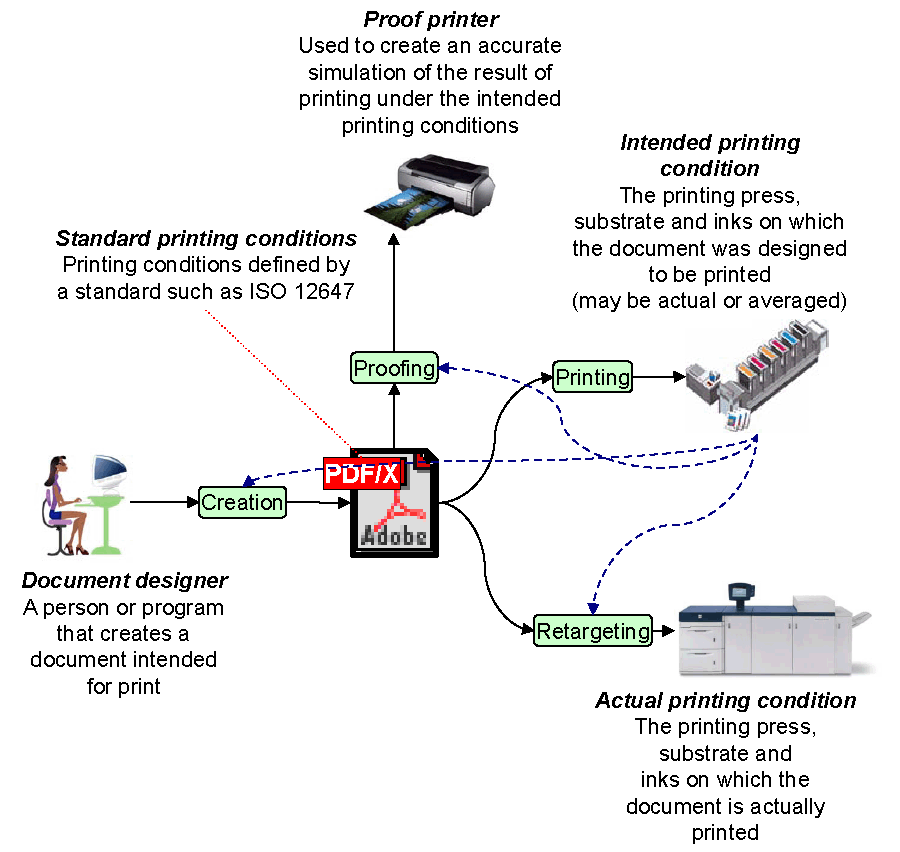- 2024
- Spectral Imaging Experts' Day
- Upcoming ICC Meetings
- 2023
- London Meeting Invited Speaker session
- 2022
- HDR Experts' Day
- 2020
- ICC DevCon 2020
- Munich, 10-11 February
- 2019
- ICC Color Experts' Day, Bressanone
- 2018
- ICC Color Symposium Hong Kong, 22 October
- Grand Rapids, MI, 30-31 May
- ICC DevCon 2018
- Munich, 25-26 February
- 2017
- Ryerson Toronto Graphic Arts Day, 13 October
- Toronto, 11-12 October
- Prague Graphic Arts Experts' Day, 29 June
- Prague, 27-28 June
- Tokyo, 19-20 April
Exchange space for 'pure digital' printing
This document describes a workflow that has been proposed for digital printing and a digital exchange space ICC profile that has been developed to support this workflow.
Conventional print workflow
The idea of an exchange colour space has been part of the workflow for graphic arts print production for some time where exchange spaces such as Fogra39, SWOP and JapanColor are widely used. In this traditional workflow images are converted to the exchange colour space using an application such as Photoshop. These CMYK images are then placed into a document and a PDF file is created (ideally PDF/X) and sent to the printer. The printer then uses the exchange colour space to create a proof of the document (hard copy or soft copy) and the proof is used to agree the printing result with the customer before the document is printed on a conventional printing press that has been calibrated to match the exchange colour space. Two calibration systems are commonly used: adjustment of TVI (the basis for PSO) and neutral tone scale adjustment (the basis for G7).
This workflow is shown in the figure below.

Digital print workflow simulating conventional print
This conventional print workflow can also be used for digital printing. The same document creation process is followed but the press calibration process is different and in this case calibration is usually achieved by creating a device link profile that provides a conversion from the exchange colour space to the native colour space of the digital printer. Care must be taken when creating such a device link profile to ensure that other printing constraints are met - for example that text is produced using only black ink.
This process is only usually suitable where the digital printer's native colour space has a colour gamut that completely encloses or at least is fairly close in size to the exchange colour space. When this workflow is used the colour gamut of the digital printer is limited to that of the exchange colour space.
'Pure Digital' printing
It is sometimes more important to use the full colour gamut of the digital printer than it is to simulate the result of a conventional printing press. There are three ways to achieve this today: (a) create a printer-specific profile for the digital printer, (b) use a conventional exchange colour space and perform gamut expansion to fill the colour gamut of the digital printer and (c) use an exchange colour space that is larger than the digital printer and convert to the digital printer's colour space using a device link profile that performs gamut mapping.
While option (a) will produce the most reliable workflow for a given digital printer the workflow is limited to a specific digital printer and it is often necessary to create documents before the actual digital printer has been selected. Furthermore there are often many configuration options for a given digital printer that makes this printer-specific workflow difficult. Option (b) is potentially more flexible however the process of gamut expansion is difficult and consequently the results may not be satisfactory.
The third option is what I have called 'pure digital' workflow. In this case the document creator know that the document will be printed using a digital printer of some kind but does not yet know which one will be used.
To enable this pure digital workflow the ICC has created a colour exchange space that is approximately the size of the Perceptual Reference Medium Gamut This is a CMYK exchange space and is intended to be used in the same way as conventional exchange colour spaces. Details of the key characteristics of this exchange space are provided in
This workflow is shown in the figure below.
Evaluating the pure digital colour exchange space
The exchange colour space may be evaluated using the following method.
Starting with the same images separate for your preferred reference printing condition (Fogra39, SWOP, JapanColor) and compare the output from these two workflows.
In these cases the starting image is the same and the resulting digital prints should be compared to check for any visible artefacts. Also the ease of use of this profile should be considered.

A PRMG-based profile has been provided (follow the link below) to allow workflows to evaluate the effectiveness of such an exchange colour space.
NOTE Channel constraints are only required for some devices. Some devices only require black constraint.

